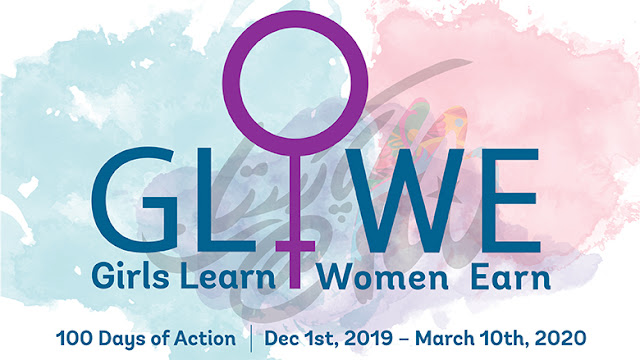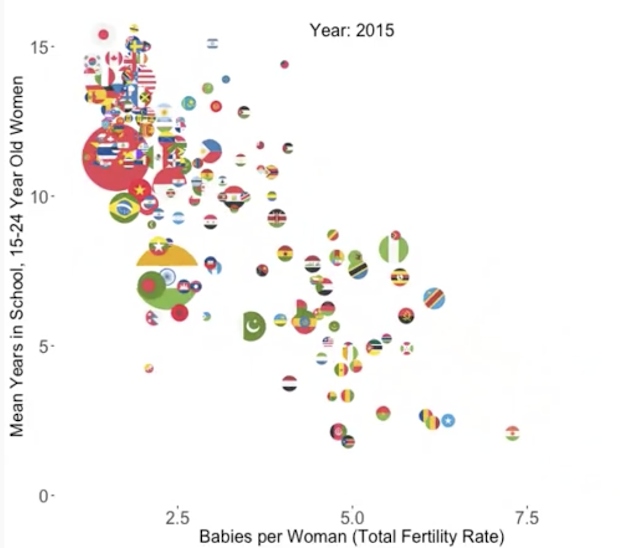PakAlumni Worldwide: The Global Social Network
The Global Social Network
Women's Day: Gender Gap in Education Narrowing in Pakistan
Women's education, literacy and labor force participation levels remain low in Pakistan but the gender gap is declining in terms of literacy rates and mean years of schooling, according to Pakistan Labor Force Survey 2017-18. There is about one year gap between men and women in terms of education attained. On average, a Pakistani male born after 1995 will leave school in 8th grade. A female born at the same time will leave in 7th grade.
At a recent Islamabad event organized as part of the World Bank's "Girls Learn, Women Earn" campaign, Mr. Illango Patchamuthu, World Bank Country Director for Pakistan, said increasing years of schooling helps women become more productive members of society.
Pakistan Labor Force survey provides information on the country's labor force characteristics. It is based on a representative sample of 43,361 urban and rural households. For this purpose, total sample size is evenly distributed into four sub samples, each to be enumerated in a given quarter.
Mean Years of Schooling in Pakistan. Source: Labor Force Survey 201... |
As of 2017-18, the overall literacy rate in Pakistan is 62.3%. Among males above age 10, 72.5% are literate. Females in the same age group are at 51.8%, trailing 20.7% behind their male counterparts. The percentage of women participating in the labor force is 24.9 as compared to 82.7 for men.
History of Literacy in Pakistan |
Educational Attainment in Pakistan. Source: Labor Force Survey 2017-18 |
At a recent Islamabad event organized as part of the World Bank's "Girls Learn, Women Earn" campaign, Mr. Illango Patchamuthu, World Bank Country Director for Pakistan, said increasing years of schooling helps women become more productive members of society. He said: “Every additional year of schooling for a girl increases her future earnings by up to 10%. Pakistan can use the untapped economic potential of women in the workforce and estimates indicate this can boost the economy by up to 30%, by empowering women and girls to expand their skills, access to information, mobility, and access to finance and assets.”
Increasing Years of Schooling Leads to Women Having Fewer Babies |
Prime Minister Imran Khan's government has launched two programs with the aim of particularly helping underprivileged women: Ehsaas and Kifaalat. These programs are headed by Dr. Sania Nishtar, a highly accomplished woman named special assistant to the prime minister. Speaking at "Girls Learn, Women Earn", Dr. Nishtar said:
“Government of Pakistan’s Ehsaas program has a very serious intent to drive forward the agenda of women empowerment. Ehsaas stringently follows fifty percent rule across the board for women inclusion in all Ehsaas initiatives including interest free loans, scholarships and asset transfers".
"Likewise, Kafaalat that has recently been launched by the Prime Minister will ensure financial and digital inclusion of 7 million disadvantaged women across Pakistan who will now benefit from the monthly stipend of Rs. 2,000 along with access to bank accounts and affordable smart phones,” she added.
Related Links:
Pakistani Woman Designer Wins Global Industrial Design Award
Pakistan's Saadia Zahidi Leads WEF's Gender Parity Effort
Gender Gap Worst in South Asia
Female Literacy Lags in South Asia
Are Women Better Off in Pakistan Today?
Religious Leaders Respond to Domestic Violence
Fighting Agents of Intolerance
-
Comment by Riaz Haq on March 9, 2020 at 10:01pm
-
The literacy rate increased by 1.6pc to 62.3pc in 2017-18, from 60.7pc in 2014-15, according to the Economic Survey of Pakistan launched on Monday.
The survey stated: “Pakistan social and living standards measurement (PSLM) survey could not be conducted in 2016-17 and 2017-18 on account of ‘Population & Housing Census in 2017’. However, according to Labour Force Survey 2017-18, literacy rate trends shows 62.3pc in 2017-18 (as compared to 60.7pc in 2014-15), males (from 71.6pc to 72.5pc) and females (from 49.6pc to 51.8pc).”
An area-wise analysis suggests that the literacy rate increased in both rural (51.9pc to 53.3pc) and urban (76pc to 76.6pc) areas
“It is also observed male-female disparity narrowing down with time span. Literacy rate increases in all provinces, Khyber Pakhtunkhwa (54.1pc to 55.3pc), Punjab (61.9pc to 64.7pc) and Balochistan (54.3pc to 55.5pc) except in Sindh (63.0pc to 62.2pc) where marginal decrease has been observed.”
Education expenditure
The survey said that expenditure on education was estimated at 2.4pc of GDP in 2017-18, compared to 2.2pc in 2016-17.
Education experts have called for at least 4pc of the GDP to go towards education.
The survey said the government is “committed” to increasing financial resources for education. It said education expenditure has risen gradually since 2013-14.
Enrolment
While discussing enrolment at the school and college level, the survey said that an increase of 7.3pc was observed in pre-primary enrolment at the national level, which increased 12.27 million in 2017-18 compared to 11.4m in 2016-17.
It said there were a total of 172,200 functioning primary schools – grades one to five – in 2017-18, with 519,000 teachers across the country. These schools had an overall enrolment of 22.9m students, an increase of 5.5pc from the previous year.
There were 46,800 middle schools in 2017-18, with 438,600 teachers and enrolment of 7.3m, an increase of 4.3pc from the enrolment level in 2016-17. Enrolment is estimated to increase by another 3.7pc to 7.6m in 2018-19.
There were a total of 30,900 high schools with 556,600 teachers functioning in the country in 2017-18. High school enrolment, at 3.9m, represents an increase of 7.4pc from the enrolment level of 3.6m in 2016-17.
High school enrolment is estimated to increase by another 6.6pc to 4.1m in 2018-19.
They survey said there were a total of 5,200 higher secondary schools and intermediate colleges with a teacher population of 121,900 in 2017-18.
It said the overall enrolment of 1.75m in these schools was a healthy increase of 9.8pc from the enrolment level in 2016-17. Enrolment is expected to rise to 1.84m, by another 5pc, in 2018-19.
A total of 3,700 technical and vocational institutes with 18,200 teachers were functional in 2017-18. The enrolment of 433,200 represents an increase of 25.6pc from the previous year. Enrolment is projected to increase by 8.7pc during 2018-19.
There were 1,657 degree colleges in the country with 42,000 teachers in 2017-18. That year, a significant decline of 47.3pc in enrolment to 503,800 was observed at the enrolment level, which is projected to decrease further by 4.3pc in 2018-19.
There were 186 universities in 2017-18, the survey said, with 56,900 teachers and a total enrolment of 1.6 million. Enrolment was 7.7pc higher than in previous years, but the survey said: “The growth in enrolment however is projected to decline by 0.2pc in 2018-19.”
https://www.dawn.com/news/1487420
-
Comment by Riaz Haq on May 22, 2022 at 5:28pm
-
So, in 2020-21 for every hundred rupees that employed men earn, women earn around eighty-one rupees. This is up from women earning seventy rupees for every hundred rupees that men earned in 2018-19. (Labor Force Survey 2020-21)
https://nation.com.pk/2022/04/29/pakistans-labour-force/Using ILO’s framework, the gender pay gap in agriculture in Pakistan is still very high—36.24 percent. The good news is that this is lower than 2018, when the gender pay gap was 40.69 percent. To put another way, in 2020-21, for every hundred rupees that men employed in the agriculture sector earn, women earn around sixty-three rupees only. This is up from women earning fifty-nine rupees for every hundred rupees that men in the agriculture sector earned in 2018-19. Again, while the gender pay gap is atrociously high, over the period of analysis it has declined and that is an absolutely positive achievement. The overall gender wage gap has almost halved over the period of analysis. So, in 2020-21 for every hundred rupees that employed men earn, women earn around eighty-one rupees. This is up from women earning seventy rupees for every hundred rupees that men earned in 2018-19.
This report paints a rosy picture of the labour force in Pakistan. But some macroeconomic issues continue to manifest. Low LFPR among the youth, urban unemployment which exerts additional pressure on the cities, gender pay gaps and disproportionate size of the informal economy. Moving forward, serious attention has to be paid on generating meaningful employment across the country, specifically in KP which has the highest rate of unemployment.
-
Comment by Riaz Haq on May 30, 2022 at 1:59pm
-
Pakistan Labor Force Survey (LFS) 2020-21
https://www.pbs.gov.pk/sites/default/files/labour_force/publication...Literacy rate goes up (62.4%, 62.8%) more in case of males (73.0%, 73.4%) than females
(51.5%, 51.9%). Area-wise rates suggest increase in rural (53.7%, 54.0%) and in urban
(76.1%, 77.3%). Male-female disparity seems to be narrowing down with the time span.
Literacy rate goes up in all provinces: KP (52.4%, 55.1%), Sindh (61.6%, 61.8%), Balochistan
(53.9%, 54.5%) and in Punjab (66.1%, 66.3%) during the comparative periods-----------------
an average monthly wages of overall paid employees is of Rs.24028
per month while the median monthly wages is Rs. 18000 per month. . However, gender
disparities were obvious in the mean monthly wages gap between males and females of Rs.
4526 in favour of males. Based on median monthly wages, the gap, still in favour of males, is
Rs. 6,900. The above table also shows that irrespective of occupation both mean and median
monthly wages of males are higher than those of females----------
4.20 Major Industry Divisions: Occupational Safety and Health
Mainly, the sufferers belong to agriculture (29.3%), construction (19.7%), manufacturing
(19.1%), wholesale & retail trade (13.7%) and transport/storage & communication (10.2%).
Female injuries in agriculture sectors are more than twice (61.7%) than that of male injuries
(26.3%). In manufacturing, female injuries (24.7%) and Community, social and personal services
(8.9%) are more than male injuries (18.6%) and (6.5%) respectively. Contrarily, males are
more vulnerable in the remaining groups. Comparative risk profiles run down for major
industries grouping while gain stream for manufacturing, transport, storage & communication
and community, social & personnel services.
-
Comment by Riaz Haq on July 6, 2022 at 9:15pm
-
The average expected years of schooling in Pakistan is 8.5 years. In comparison it is 11.2 years in Bangladesh and 12.3 years in India. Pakistan has performed poorly even on inequality adjusted human development, as well as gender development and equality compared with the regional countries.
https://www.dawn.com/news/1522407#:~:text=The%20average%20expected%....
Comment
Twitter Feed
Live Traffic Feed
Sponsored Links
South Asia Investor Review
Investor Information Blog
Haq's Musings
Riaz Haq's Current Affairs Blog
Please Bookmark This Page!
Blog Posts
Happy New Year 2026: Pakistan's Year 2025 in Review
As we enter the year 2026, it is time to review the year 2025 and wish you all Happy New Year 2026! May it bring peace, prosperity and happiness to all!!
The year 2025 saw Pakistan defeat a brazen Indian attack on its soil, while reviving its economy and…
ContinuePosted by Riaz Haq on December 30, 2025 at 9:30pm — 3 Comments
PIA Privatization: Can it Bring Back Pakistan National Airline's Glory Days?
After decades of failed attempts, the Government of Pakistan has finally privatized the Pakistan International Airline (PIA) under intense pressure from the International Monetary Fund (IMF). Nonetheless, it is a deal that will give the national airline not only a chance to survive but to thrive in the long run. As part of structuring the sale for Rs. 135 billion, the government has assumed Rs. 654…
ContinuePosted by Riaz Haq on December 25, 2025 at 10:30am — 6 Comments
© 2026 Created by Riaz Haq.
Powered by
![]()






You need to be a member of PakAlumni Worldwide: The Global Social Network to add comments!
Join PakAlumni Worldwide: The Global Social Network